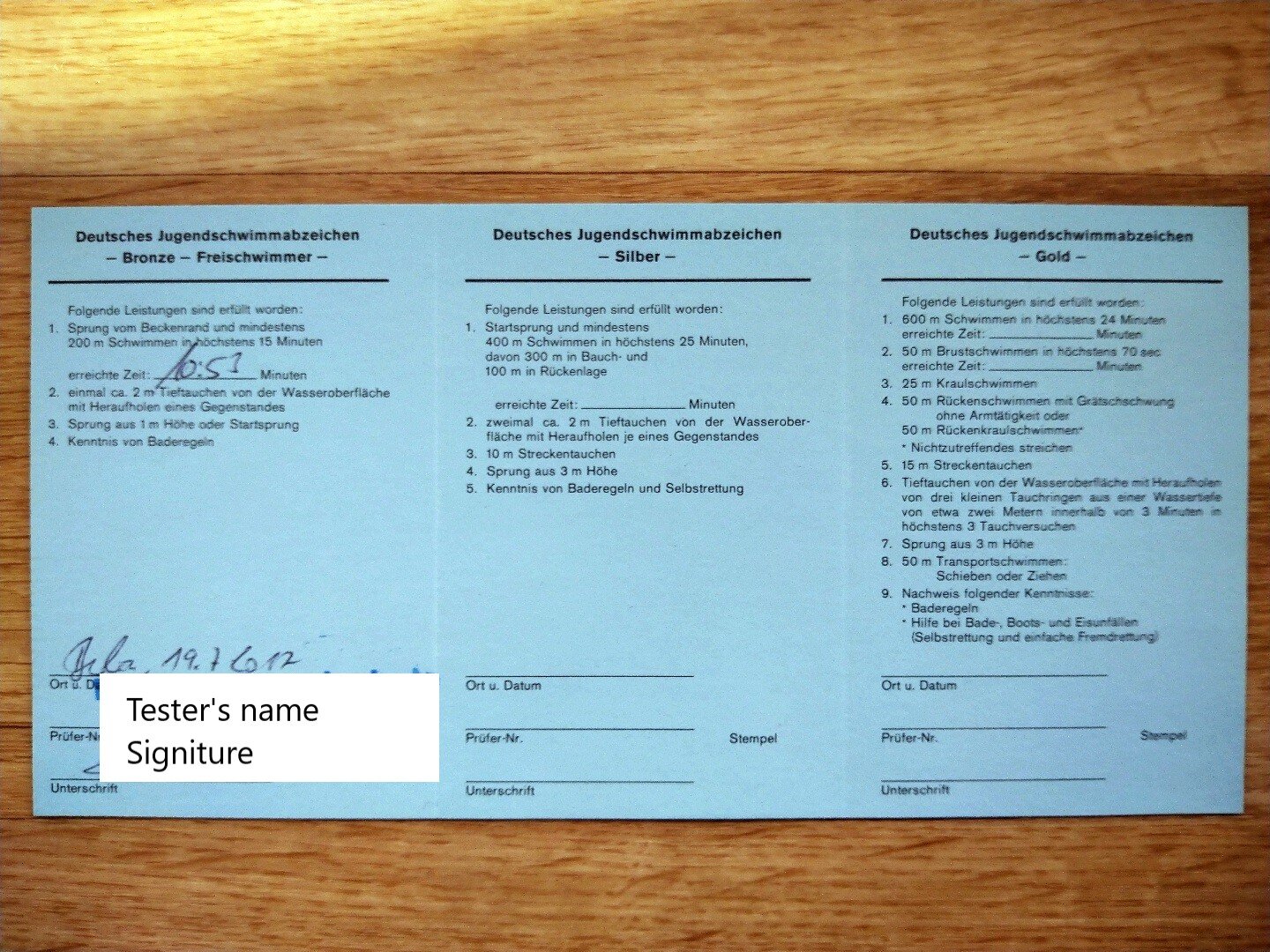At the elementary school in Berlin that my son attended, swimming lessons were incorporated into the curriculum only during the third grade, with one session per week throughout the academic year. As the school did not have an on-site swimming pool, students walked together to a nearby public indoor pool for their lessons. To my knowledge, there are no elementary schools in Berlin equipped with their own swimming pools.
In contrast, in elementary schools in Japan, swimming lessons are conducted every summer from the first through the sixth grade. Furthermore, swimming instruction continues through junior and senior high school levels during the summer months. The pools are typically located on school premises, and all activities, including changing clothes, are completed within the regular physical education period.
This study aims to examine the differences in the swimming education environments and instructional methods between Japan and Germany.
1. Swimming Education in Germany
1.1 School-Based Swimming LessonsAs mentioned earlier, in Berlin, students have swimming lessons only during the third grade, once a week throughout the year. Elementary schools in the region do not have their own swimming pools. Consequently, children have to go to the nearest public pool for the swimming class.
The primary objective of these lessons is to equip children with swimming skills to prevent water-related accidents. At the end of the year, a swimming proficiency test is conducted to assess their progress. The goal is for students to achieve the Bronze level, which signifies the ability to swim independently. This certification system was established in the 1970s through a collaboration between the Federal Ministry of Culture and Education and the National Association for the Promotion of Swimming Training in Germany.*1
1.2 Four Levels of Swimming ProficiencyIn Germany, swimming and lifesaving skills are categorized into four proficiency levels, including the aforementioned Bronze level. The following outlines the requirements for each level, progressing from beginner to advanced.*2
1) Seahorse (Beginner Level: For Children Under 18)- Able to jump into the pool from the edge and swim 25 meters using either the breaststroke or backstroke.
- Able to retrieve an object from the pool floor at a depth that reaches the child's shoulders.
- Understands basic safety rules in aquatic environments, such as:
- Taking a shower before swimming.
- Avoiding swimming when feeling unwell.
- Refraining from entering the water on a full or empty stomach.
- Not running on the poolside.
- Not obstructing other swimmers.
- Staying within water depths below chest level if unable to swim.
- Immediately leaving the water and seeking shelter indoors during thunderstorms.
- Avoiding diving into water that is unclear or unexpectedly deep.
- Able to jump into the pool from the edge and swim 200 meters using either the breaststroke or backstroke within 15 minutes.
- Able to retrieve an object from the bottom of a pool with a depth of 2 meters.
- Able to dive into the water from a height of 1 meter.
- Understands and follows pool safety rules, such as:
- Taking a shower before swimming.
- Avoiding swimming when feeling unwell.
- Refraining from entering the water on a full or empty stomach.
- Not running on the poolside.
- Not obstructing other swimmers.
- Staying within water depths below chest level if unable to swim.
- Immediately leaving the water and seeking shelter indoors during thunderstorms.
- Avoiding diving into water that is unclear or unexpectedly deep.
- Able to start with a dive and swim 400 meters within 25 minutes, including 300 meters using the breaststroke and 100 meters using the backstroke.
- Able to retrieve two objects from a depth of 2 meters.
- Able to swim 10 meters underwater continuously.
- Able to dive into the water from a height of 3 meters.
- In addition to understanding swimming environment rules, possesses knowledge of self-rescue techniques, such as conserving energy and floating in water during emergencies.
- Able to swim 600 meters within 24 minutes (no restrictions on stroke type).
- Able to swim 50 meters using the breaststroke within 70 seconds.
- Able to swim 25 meters using the front crawl.
- Able to swim 50 meters using the backstroke.
- Able to swim 15 meters underwater continuously.
- Able to locate and retrieve three submerged objects at a depth of 2 meters within 3 minutes while swimming.
- Able to dive into the water from a height of 3 meters.
- Able to pull or push another person 50 meters in the water.
In addition to following general swimming safety rules (e.g., not running on the poolside or obstructing other swimmers), possesses knowledge of self-rescue and lifesaving techniques for both self and others' safety, including responses to accidents in water, on boats, and on ice surfaces. It is noteworthy to mention that the swimming proficiency levels in Germany do not solely focus on swimming skills but also incorporate elements such as diving from high platforms, retrieving objects underwater, and preparing for real-life aquatic environments, including potential water-related accidents.
In Germany, many people swim not only in pools but also in lakes and rivers, where lifeguard supervision is often minimal or nonexistent. Consequently, swimming instruction prioritizes the acquisition of breaststroke or backstroke, which are considered more practical for such natural environments. Furthermore, a key objective of achieving these proficiency levels is to equip individuals with lifesaving skills to respond effectively in emergency situations.
Interestingly, passing the Seahorse level does not certify one as being able to swim; instead, you only earn a badge featuring a seahorse. Only upon passing the Bronze level or higher, you are officially recognized as a swimmer and awarded a "Swimming Pass," which is standardized nationwide in Germany. If individuals wish to progress to Silver or Gold levels, they must attend swimming schools and take additional tests.


1.3 Swimming Schools in Germany
In Berlin, most swimming schools are operated by municipal pool management companies. Berlin has a population of approximately 3.5 million, but there are only 15 such swimming schools--significantly fewer than in Japan. While some outdoor pools are open during the summer, public pools are generally closed on weekends or only open for general use, meaning swimming lessons are not available on those days.*3
Despite this situation, performance in swimming lessons accounts for one-third of physical education grades. Therefore, many children attend swimming schools from an early age to prepare for the third-grade swimming lessons at school.
2. Swimming Education in Japan
2.1. School LessonsIn Japan, swimming lessons are conducted every summer from first to sixth grade. As of 2018, 94% of public elementary schools had outdoor pools, and even with a slight decline, the percentage was still 87% in 2021.*4
Japan's unique swimming education has historical roots in samurai martial arts, where swimming was considered a survival skill during battles. Surrounded by the sea and rivers, swimming was essential for survival in case of military retreat. Japan's oldest pool dates back about 200 years to the Edo period.*4 Modern school swimming lessons were also introduced for safety reasons. After a 1955 maritime accident in which a ferry carrying elementary and junior high school students sank, resulting in 168 deaths, there was a growing call for swimming education in schools. The Tokyo Olympics further accelerated the construction of school pools, supported by government in the 1960s and 1970s.*4
Unlike Germany, where survival techniques are emphasized, currently, the school pools in Japan are equipped with starting blocks, and much of the lesson time is spent on stroke techniques such as freestyle and breaststroke. Clothed swimming lessons for survival are limited to about once a year, which makes a difference from the samurai-era and swimming education in Germany.
2.2. Swimming Schools in Japan and My Son's ExperienceJapan has over 1,000 swimming schools, with more than 100 in Tokyo alone.*5 In Yokohama, where my parents live, there are at least five schools within a 30-minute radius.
My son attended a swimming school in Berlin for two months during kindergarten to get used to the water. Later, during his summer visits to Japan, he participated in intensive swimming courses at different schools. I was always impressed by the number of swimming schools in Japan and the detailed coaching on how to relax, move arms and legs, and breathe correctly.
In Japan, the learning sequence is "glide → kick → freestyle." Breaststroke is taught only after freestyle. By the time my son entered third grade, he had just learned freestyle but had never been taught breaststroke.
Consequently, he was placed in the "non-swimmer" group at his local school when he was back in Berlin and practiced in shallow water until he could swim 25 meters. Once he achieved this, he moved to the "swimmer" group, where practice was conducted in deep water over 2 meters deep.
Unlike Japan, German swimming lessons followed a "learn by doing" approach with little detailed instruction. Since swimming accounted for one-third of his PE grade, we often practiced as a family on weekends, leading to his successful Bronze-level certification after a year.
By the way, to reach the bronze level, you need to master the breaststroke or backstroke, but in fact all of his classmates swam breaststroke. Also, in breaststroke, they didn't need to put their faces down, they just had to keep their faces up and swim 200 meters.
Conclusion
As my son used to say back then, swimming is primarily viewed as a lifesaving skill rather than a competitive sport in Germany. The focus is on endurance and survival techniques, particularly breaststroke, as it conserves energy. Unlike in Japan, other strokes such as freestyle are not taught. This came as a shock to me, as I also learned to swim in Japan in the order of "glide → kick → freestyle." Before coming to Germany, I had never really thought about swimming from the perspective of life extension or saving. However, here in Germany, when it gets warm, you often see people swimming in the many lakes, and there are not always lifeguards at such places. Given that many people swim in natural waters, often without lifeguards, this approach is quite logical.
References
- *1 "Der Verein" Der Bundesverband zur Förderung der Schwimmausbildung (BFS) https://bfs-schwimmausbildung.de/der-verein
- *2 "Schwimmausbildung beim DLRG" Deutsche Lebens-Rettungs-Gesellschaft (DLRG)https://www.dlrg.de/informieren/ausbildung/schwimmabzeichen/
- *3 "Schwimmenkurs"Berliner Bäder-Betriebe https://www.berlinerbaeder.de/schwimmkurse/
- *4 "Sekaiteki ni mezurashii gakkou no puru, nesshin na suiei jugyou wa bugei ga yurai? ...Minaosareru manabu mokuteki [Swimming pools at school - rare cases in the world: Did the enthusiastic swimming lessons have their origins in martial arts? ... The purpose of learning is being reconsidered] (In Japanese)" 2024/08/11 Yomiuri Shimbun Online https://www.yomiuri.co.jp/kyoiku/kyoiku/news/20240810-OYT1T50186/
- *5 "Suimingu kurabu gyoukai no M&A/kaisha baikyaku [M&A and company sales in the swimming club industry]" (In Japanese) Small and medium-sized enterprises M&A Support Co., Ltd. https://www.chusho-ma-support.com/kaisyabaikyaku/kaisyabaikyaku_055/














